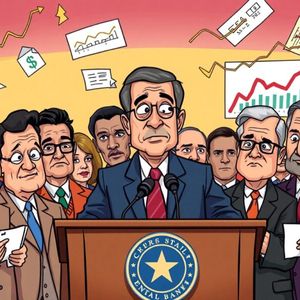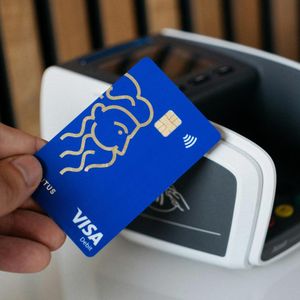FOMC Meeting: Powell Hails ‘Successful’ Outcome Amidst Rate Debates
9 min read
BitcoinWorld FOMC Meeting: Powell Hails ‘Successful’ Outcome Amidst Rate Debates In the dynamic world of finance, few events capture as much attention as a Federal Open Market Committee (FOMC) meeting. For cryptocurrency enthusiasts and investors, these gatherings of the Federal Reserve’s top policymakers are pivotal, as their decisions ripple across global markets, influencing everything from stock prices to the volatility of digital assets. Recently, Federal Reserve Chairman Jerome Powell offered a noteworthy assessment of the latest FOMC meeting , declaring it ‘quite successful’ despite internal disagreements on the path of interest rates. This seemingly minor detail carries significant weight, signaling the Fed’s confidence in its strategy even as voices within advocate for different approaches. Understanding the nuances of these discussions is crucial for anyone navigating the intricate landscape where traditional finance meets the burgeoning crypto economy. What Made the Latest FOMC Meeting ‘Quite Successful’ in Powell’s View? Chairman Powell’s positive assessment of the recent FOMC meeting might seem counterintuitive to some, especially given the public acknowledgment of dissenting views. However, his definition of ‘success’ often extends beyond unanimous agreement on a single policy decision. For the Federal Reserve, a successful meeting typically involves: Clear Communication: The ability to articulate the committee’s decision and rationale clearly to the public and markets, minimizing uncertainty. Consensus Building: Even with disagreements, reaching a broad consensus on the main policy stance, demonstrating unity in purpose. Data-Driven Decisions: Ensuring that discussions and decisions are firmly rooted in economic data and the Fed’s dual mandate of maximum employment and price stability. Constructive Debate: Allowing members to express diverse viewpoints, fostering a robust intellectual environment that challenges assumptions and leads to more informed outcomes. Powell specifically mentioned that the members who opposed the interest rate freeze, Governors Waller and Bowman, are expected to explain their perspectives within two days. He emphasized that such disagreement is ‘not surprising,’ highlighting the healthy debate inherent in the policymaking process. This openness to dissent, rather than suppressing it, can be seen as a strength, reinforcing the institution’s commitment to thorough analysis and diverse perspectives. The ability to maintain overall cohesion and a unified message despite varied opinions is a hallmark of effective leadership in a complex organization like the Federal Reserve. Unpacking the Dissent: Why Did Some Oppose the Interest Rate Freeze at the FOMC Meeting ? The dissenting voices of Governors Waller and Bowman provide a fascinating glimpse into the ongoing debate within the Federal Reserve regarding monetary policy. Powell indicated that these two members believe ‘now is the time to lower interest rates.’ This stance puts them at odds with the majority, who voted to maintain the current interest rate levels. Understanding their potential reasoning involves looking at different economic philosophies and current conditions: Arguments for Lowering Interest Rates: Stimulating Economic Growth: Lower rates make borrowing cheaper for businesses and consumers, encouraging investment, spending, and job creation. Preventing Recession: If there are signs of economic slowdown, lowering rates can act as a preventative measure to avoid a deeper downturn. Addressing Deflationary Pressures: While less likely in the current environment, persistent low inflation or deflation could warrant rate cuts to boost prices. Supporting Specific Sectors: Industries sensitive to interest rates, like housing or manufacturing, could benefit from lower borrowing costs. Arguments for Maintaining or Raising Interest Rates (the Majority View): Combating Inflation: Higher rates reduce demand by making borrowing more expensive, which helps to bring down stubbornly high inflation. Maintaining Price Stability: The Fed’s primary goal is to ensure prices remain stable, and sometimes that requires keeping rates elevated. Building ‘Dry Powder’: Keeping rates higher allows the Fed more room to cut rates significantly if a severe economic downturn occurs in the future. Ensuring Sustainable Growth: Preventing the economy from overheating, which could lead to asset bubbles or unsustainable wage growth. The Federal Reserve’s approach is often described as ‘data-dependent,’ meaning decisions are made based on the latest economic indicators, including inflation, employment figures, and GDP growth. The disagreement likely stems from differing interpretations of these data points or varying forecasts for the economy’s trajectory. For instance, Waller and Bowman might see sufficient progress on inflation to warrant a proactive cut, perhaps to avoid overtightening and triggering a recession, while the majority might prioritize ensuring inflation is firmly on a sustainable path back to the 2% target before making any moves. How Do Federal Reserve Decisions from the FOMC Meeting Impact the Crypto Market? While the Federal Reserve’s mandate focuses on the U.S. economy, its decisions, particularly those made at an FOMC meeting , have profound global implications, significantly influencing risk assets like cryptocurrencies. The connection is multi-faceted: 1. Liquidity and Risk Appetite: Lower Interest Rates: When interest rates are low, borrowing money becomes cheaper. This increases overall liquidity in the financial system. Investors are more inclined to seek higher returns in riskier assets, as traditional safe havens like savings accounts or government bonds offer minimal yields. This ‘search for yield’ often pushes capital into cryptocurrencies, leading to price appreciation. Higher Interest Rates: Conversely, higher rates make borrowing more expensive and reduce liquidity. Capital tends to flow out of riskier assets and into safer, yield-bearing investments. This can lead to selling pressure on cryptocurrencies, as investors become more risk-averse. 2. Dollar Strength: Interest rate differentials directly impact currency valuations. When the Federal Reserve maintains higher rates relative to other major central banks, the U.S. dollar tends to strengthen. A stronger dollar can make dollar-denominated assets, including Bitcoin, less attractive to international investors, potentially leading to outflows. Conversely, a weaker dollar, often associated with lower interest rates, can make crypto more appealing as a hedge or alternative store of value. 3. Investor Sentiment and Certainty: Clear communication and predictable policy from the Federal Reserve can reduce market uncertainty. When investors have a better understanding of the Fed’s intentions, they can make more informed decisions. Unanticipated policy shifts or heightened internal disagreements, however, can introduce volatility and dampen investor confidence across all asset classes, including crypto. 4. Inflation Hedge Narrative: Cryptocurrencies, particularly Bitcoin, are often touted as an inflation hedge. However, the effectiveness of this narrative can be challenged by the Fed’s actions. If the Fed successfully combats inflation through interest rate hikes, the perceived need for an inflation hedge might diminish. Conversely, if inflation persists despite Fed efforts, or if the Fed is perceived as behind the curve, the inflation hedge narrative for crypto could strengthen. The takeaway is clear: while crypto markets have their unique drivers, they are not immune to the gravitational pull of traditional monetary policy. The Fed’s stance on interest rates, influenced by its assessment of economic conditions, remains a critical factor for cryptocurrency investors to monitor. Navigating the Future: What’s Next for Interest Rates After the FOMC Meeting ? Following the recent FOMC meeting , the market’s focus now shifts to the Federal Reserve’s forward guidance and the trajectory of interest rates. While Powell affirmed the meeting’s success, the underlying economic landscape remains complex, with inflation still above the Fed’s 2% target and a robust, though potentially cooling, labor market. Key Factors the Federal Reserve Will Be Watching: Inflation Data: The Consumer Price Index (CPI) and Personal Consumption Expenditures (PCE) index will be paramount. A sustained downward trend in these indicators is essential for the Fed to consider rate cuts. Labor Market: Employment figures, wage growth, and unemployment rates will inform the Fed’s view on the health of the economy and potential inflationary pressures from wages. Economic Growth (GDP): Signs of significant slowdown or recession would likely prompt the Fed to consider easing monetary policy. Global Economic Conditions: International developments, including geopolitical events and economic performance in major trading partners, can also influence the Fed’s decisions. The market largely anticipates rate cuts later in the year, but the timing and magnitude remain uncertain. Powell’s comments suggest a cautious approach, emphasizing data dependency over pre-set schedules. This means that each subsequent economic report will be scrutinized for clues about the Fed’s next move. For investors, this environment demands vigilance and adaptability. Actionable Insights for Investors: Stay Informed: Regularly follow Federal Reserve announcements, economic data releases, and expert analyses. Diversify Your Portfolio: Don’t put all your eggs in one basket. A diversified portfolio can help mitigate risks associated with interest rate fluctuations. Understand Risk Tolerance: Assess your personal risk tolerance and adjust your exposure to volatile assets like cryptocurrencies accordingly. Long-Term Perspective: For crypto investors, focusing on the long-term fundamentals of projects rather than short-term price swings driven by macro factors can be beneficial. Conclusion: A Successful Step Forward Amidst Ongoing Debates Federal Reserve Chairman Jerome Powell’s declaration of a ‘quite successful’ FOMC meeting underscores the central bank’s confidence in its current policy trajectory, even as internal discussions reveal differing views on the optimal path for interest rates. The willingness to acknowledge and discuss dissent, rather than hide it, speaks to the robustness of the Fed’s decision-making process. While some members advocate for immediate rate cuts to stimulate the economy, the majority’s decision to hold rates reflects a cautious, data-dependent approach aimed at ensuring long-term price stability. For the cryptocurrency market, the implications of these decisions are profound, influencing liquidity, risk appetite, and investor sentiment. As the Federal Reserve navigates the complex interplay of inflation, employment, and global economic forces, its actions will continue to be a primary driver of market trends. Staying attuned to these developments, understanding the underlying economic principles, and adopting a well-informed investment strategy will be key for navigating the evolving financial landscape. Frequently Asked Questions (FAQs) 1. What is the Federal Open Market Committee (FOMC)? The FOMC is the monetary policymaking body of the Federal Reserve System. It consists of twelve members: the seven members of the Board of Governors, the president of the Federal Reserve Bank of New York (FRBNY), and presidents of four other Federal Reserve Banks on a rotating basis. The FOMC holds eight regularly scheduled meetings per year to discuss and decide on interest rates and other monetary policy tools. 2. Why is a ‘successful’ FOMC meeting important for the economy? A ‘successful’ FOMC meeting , as described by Chairman Powell, implies that the committee has reached a clear and unified policy decision, even with internal disagreements, and effectively communicated its rationale to the public. This clarity helps stabilize financial markets, guides investor expectations, and provides businesses and consumers with a predictable economic environment, fostering confidence and informed decision-making. 3. How do interest rate decisions affect inflation? Interest rate decisions are a primary tool for managing inflation. When the Federal Reserve raises interest rates, it makes borrowing more expensive, which reduces consumer spending and business investment. This decrease in demand helps to cool down an overheating economy and bring inflation down. Conversely, lowering rates stimulates borrowing and spending, which can lead to higher inflation if the economy is already strong. 4. What does it mean for Federal Reserve members to dissent? Dissent in the Federal Reserve refers to a member of the FOMC voting against the majority’s decision on monetary policy. It signifies that while a consensus was reached, not all members agreed with the chosen path. Dissenting opinions are part of the transparent and deliberative process, reflecting diverse economic perspectives and interpretations of data among the committee members. Their reasons for dissent are usually published in the meeting minutes. 5. When is the next FOMC meeting scheduled? The Federal Open Market Committee (FOMC) holds eight regularly scheduled meetings each year, approximately every six weeks. The exact dates for upcoming meetings are publicly available on the Federal Reserve Board’s website. Investors and market watchers closely monitor these dates for policy announcements and economic projections. If you found this article insightful, consider sharing it with your network! Your support helps us continue providing valuable insights into the intersection of traditional finance and the evolving crypto world. Share this article on social media to help others understand the critical impact of FOMC decisions. To learn more about the latest crypto market trends, explore our article on key developments shaping Bitcoin price action. This post FOMC Meeting: Powell Hails ‘Successful’ Outcome Amidst Rate Debates first appeared on BitcoinWorld and is written by Editorial Team

Source: Bitcoin World



